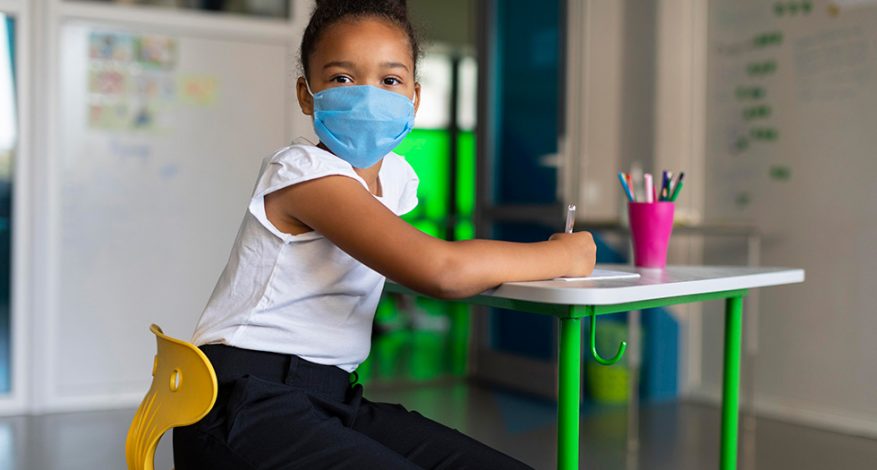“With the right support, parents/guardians can learn
how to create an environment that allows their children to thrive” – Shonelle George
The COVID-19 pandemic has interrupted the normal functioning and activities within our daily lives. With the implementation of social distancing, the institution of remote learning programs, and homeschooling, the pandemic has triggered internally generated feelings of worry, fear, anxiety, helplessness, and the externally generated reality of uncertainty that contribute to growing cases of psychological distress. For many children, the pandemic has interrupted their ability to function normally. Social seclusion and feelings of loneliness have emerged as risk factors for developing depression and anxiety disorders (Karasmanaki & Tsantopoulos, 2021).
Researchers have found that individuals in quarantine have been experiencing negative emotions like stress, irritability, fear, frustration, boredom, confusion, anger and can also develop post-traumatic stress disorder (PTSD) and insomnia (Loades et al., 2020). Coupled with the fear of infection, professional displacement or joblessness, limited access to medical care and medications, fear of uncertainty exacerbates already existing negative emotions (Loades et al., 2020). Younger children are more susceptible to mental health crises due to social distancing in comparison to adults (Deighton et al., 2019) and their life stressors and symptom markers for emotional or behavioral distress present as withdrawal, anxiousness, irritability, crankiness, appetite changes, muscle tension, nausea, and in younger children, clinginess, startling easily, excessive crying or tantrums, poor sleeping, or headaches (Weir, 2017).
Since children and teens are also adjusting to the new reality of spending more time at home and engaging in fewer social interactions with their peers, the stress of these changes can cause significant problems in their relationships, work productivity, and communication skills. Being cooped up in the house with few outlets to expel energy lends to increased instances of tantrums, irritability, and withdrawal (Karasmanaki & Tsantopoulos, 2021). In these instances, taking time to care for your child/ren’s emotional health is strongly encouraged.
The following strategies provide practical tools to help parents/guardians to support their children as they cope with distance learning during COVID 19:
- Check-in on their Feelings. Parents can practice asking questions like, how are you feeling today? What do you miss most about being in school? What can I do to support you today? Asking open-ended and close-ended questions allows your child the opportunity to reflect on how they feel and can provide helpful insight into how they are processing their emotions. Their responses will give you the access you need to support them. Remind them that they are loved.
- Be Flexible and Demonstrate more Understanding. It’s ok to be flexible. Allow your child to have breaks during the day, be a little more lenient when it comes to how and when they complete their assignments. If playing music helps them or being in a quiet space helps, make those accommodations for them. If you observe that your child is overwhelmed with school assignments, allow them time away from the task to refocus and then revisit the work with them when you are both in the right frame of mind to process the demands of the task. Exercise just a tad more understanding. Some children are still adjusting to the lack of in-person interaction with their teachers and peers and may not like virtual learning. Allowing your child some flexibility and demonstrating more understanding can help in their adjustment. Don’t be afraid to implement a plan that does work.
- Create Opportunities for Collaborative Activities/Family Fun. While teens may want to spend more time on their devices watching or making tik tok videos, DMing their friends, or playing video games, parents/guardians must create a healthy balance for teens. Collaborative activities aka family fun, like DIY projects, family dinners, playing board games, watching a movie or crafting, support their socioemotional development and creates an opportunity for family bonding.
- Integrate Deep Breathing Exercises in Daily Activities. The respiratory system comprises of a network of organs and tissues that help human beings to breathe. Taking deep breaths allows the body to exchange incoming oxygen with outgoing carbon dioxide. Taking slow deep breaths lowers or stabilizes blood pressure, reduces tension, and anxiety, particularly in stressful situations. Deep breathing also improves concentration and memory. By practicing slow, deep breathing, the mind will calm down, and the body begins to relax, returning to homeostasis (balance) (Dhabhar, 2011). Breathing enhances one’s capacity to manage stress. Incorporating breathing exercises into your child’s daily activities can calm and help them manage difficult emotions as they arise.
- Modify or Create a Routine. We have heard a lot of talk about establishing a routine and you may have tried this already and it worked for a bit, but you were unable to sustain it. It is ok to modify your routine. It is ok to try again. Routines create structure and make tasks at home more manageable. Have children get dressed for virtual school so that they can shift their mindset to a more structured model for learning. This will encourage more productivity. Include family breakfast, snack time and quiet time into the routine. Create a separate zone for work so that work stays in its area. This will send a message to your brain that work is over and will shift your thinking to areas outside of work. Most importantly, include some “me time” in the routine.
- Extracurricular and Physical Activities. Many businesses have been able to reopen with the implementation of COVID health practices. If you feel comfortable, enroll your child in an extracurricular activity to keep them active while learning a skill and developing discipline. This may provide some balance and bring some normalcy to their daily routine. If the activity has a physical component this can be extremely helpful for their physical and mental wellness. Physical activity has been known to reduce stress, increase mental and emotional wellness, and regulate body function (CDC, 2020). Some medical providers even consider exercise to be a useful adjunct (complement) to antidepressant medication. Simply put, exercise improves mood and holistic wellness. Exercise does not have to be intimidating. Walking in the park, jogging, lifting light weights, dancing to favorite song, yoga, and aerobics can support your family’s physical activity goals.
Distance learning during COVID is not easy. Parents/guardians are challenged by several environmental factors, including their work obligations, space, and resources to accommodate their child’s learning needs, internet bandwidth, and various complex fears. It is critical that parents become more attentive to changes in their child(ren) emotions and behavior. Spend time observing your child for behaviors that are not normal and present themselves for periods longer than one month. Maladaptive behaviors are often indicators of more serious challenges to wellness, in those cases, seek help from a professional. With the right support, parents/guardians can learn how to create an environment that allows their children to thrive.
References
Central for Disease Control. (2020). Physical Activity. https://www.cdc.gov/physicalactivity/index.html
Contrada, R. J. (2011). Stress, adaptation, and health. In R. J. Contrada & Baum (Eds.), The handbook of stress science: Biology, psychology, and health (pp. 1–9). New York, NY: Springer Publishing Company.
Deighton, J., Lereya, S., Casey, P., Patalay, P., Humphrey, N., & Wolpert, M. (2019). Prevalence of mental health problems in schools: Poverty and other risk factors among 28 000 adolescents in England. British Journal of Psychiatry, 215(3), 565-567. https://doi.org/10.1192/bjp.2019.19
Dhabhar, F. S. (2011). Effects of stress on immune function: Implications for immunoprotection and immunopathology. In R. J. Contrada & A. Baum (Eds.), The handbook of stress science: Biology, psychology, and health (pp. 47–63). New York, NY: Springer Publishing Company.
Karasmanaki, E., & Tsantopoulos, G. (2021). Impacts of social distancing during COVID-19 pandemic on the daily life of forestry students. Children & Youth Services Review, 120, N.PAG. https://doi.org/10.1016/j.childyouth.2020.105781
Loades, M. E. et al. (2020). Rapid Systematic Review: The Impact of Social Isolation and Loneliness on the Mental Health of Children and Adolescents in the Context of COVID-19. Journal of the American Academy of Child & Adolescent Psychiatry, 59 (11), 1218 – 1239.e https://doi.org/10.1016/j.jaac.2020.05.009
Weir, K. (2017). Brighter futures for anxious kids. Monitor on Psychology, 48(3). http://www.apa.org/monitor/2017/03/anxious-kids
For telehealth Services: https://www.northeastpsychological.com/
 SHONELLE
SHONELLE
Shonelle George is a clinical psychotherapist. Her clinical orientation is focused on allowing individuals to delve beneath the surface of their problems and emotions to uncover the conflicts that prevent them from living their best lives. She also believes in an integrated approach to addressing challenges to wellness. She is passionate about advocating for women and girls, which has allowed her to create psychoeducational and socioemotional workshops that focus on self-esteem/self-concept, relational trauma, anxiety, relationships, stress and coping, and mindfulness meditation. Shonelle is an international workshop presenter, motivational speaker, blogger, and currently serves as the public affairs and media director for 4 Real Women International, Inc. As an advocate, she believes that everyone can become agents of social change in their spaces of influence.
